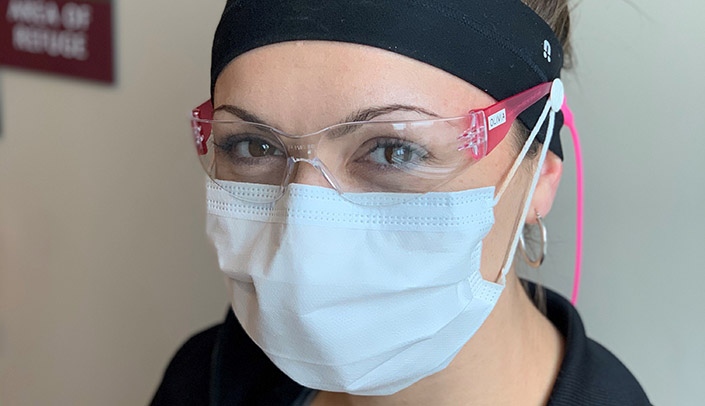Health care providers are not new to wearing protective eyewear. In order to protect themselves from possible bloodborne or chemical exposures, according to EC-68, protective eyewear must be worn during tasks where potential splash could occur. Since the onset of this pandemic, front-line providers of our COVID-19 positive patients have worn protective eyewear in the form of a face shield or goggles.
To provide our patient care colleagues another layer of protection, Nebraska Medicine has adopted a universal personal protective equipment (PPE) policy that now includes eyewear. For now, this change impacts any colleague who interacts directly with patients in an inpatient setting.
“Our understanding of COVID-19 has evolved throughout the pandemic,” said Micah Beachy, D.O., vice president and chief quality officer at Nebraska Medicine. “We now know that patients without typical symptoms can transmit the virus to others. And while having both patients and staff wear masks greatly reduces the risk of infection, the addition of eyewear further reduces that risk and helps to protect our staff.”
This change will not impact existing PPE protocols in the COVID-19 units or existing protocols for bloodborne pathogen exposure.
Colleagues who work in the inpatient setting and don’t currently have protective eyewear should work with their managers or administrators to obtain eyewear that can be worn during patient interactions.
Inpatient managers and leads can call central supply (or place an order in One Chart) to ensure their staff has one pair of eye protection.
Physicians can work with their UNMC administrators to obtain eye protection.
“The prevalence of COVID-19 in our community is increasing,” Dr. Beachy said. “If expanded eye protection saves even a few of our team members from an exposure, it’s worth it.”
As we build our inventory of eyewear, more information will be coming soon about expansion to the ambulatory environment.
Frequently asked questions:
What is universal eye protection?
We’re asking anyone who comes into direct contact with patients to wear eye protection, which includes safety glasses, goggles or a face shield. This involves anyone who comes within 6 feet of a patient or enters a patient hospital room, clinic or exam room. We will expand this policy to clinic settings when we’ve obtained more eye protection.
Why are we doing this?
The rate of COVID-19 continues to increase in our community. This means the risk of an exposure continues to increase, even in patients who are low risk and asymptomatic. When staff and patients wear a mask, we believe it greatly decreases the risk of infection. And we feel this additional precaution could further decrease the risk.
What evidence supports the move to universal eye protection?
Transmission of COVID-19 primarily happens when droplets from an infected person come into contact with mucus membranes. Masks are recommended to protect the airway. Eye protection is recommended as infectious droplets could come into contact with the eye and spread down the tear duct into the respiratory tract. Use of eye protection and universal masking prevents this transmission from occurring. We expect this guidance to evolve as we learn more about COVID-19.
I don’t have eye protection. How do I get it?
Your manager/lead will provide each staff member who has direct contact with patients a pair of eye protection. You are welcome to buy your own pair if you prefer to have more than one pair or prefer a certain style/fit at your own expense. It must conform to the ANSI Z87.1 standard.
If I am a medical receptionist or Patient Access colleague, do I have to wear eye protection?
We will expand this policy to include clinic environments as soon as we obtain more eye protection. When that happens, if you come into direct contact with patients, you will need to wear eye protection.
If I already wear eyeglasses for my vision, do I also have to wear safety glasses?
Yes. If you would prefer, you can purchase clips for the side of your eyeglasses. It must conform to the ANSI Z87.1 standard.
I wear contact lenses. Do I need to wear protective eyewear?
Yes, you should wear eye protection.
I don’t provide patient care, but I do enter hospital rooms for my job. Do I need to wear eye protection?
If a patient is present, yes.
Do I have to wear eye protection anywhere in my unit? Like when I’m at a workstation?
You need to wear eye protection when you anticipate coming into contact with a patient.
What is the proper way to remove eye protection?
When removing your eye protection, please follow the same process for removing your mask. Remember to use hand hygiene.
What is the proper way to clean safety glasses?
Use a germicidal disinfectant to clean your glasses when they become soiled.
If my work brings me to the hospital, must I wear eye protection?
You need to wear eye protection if you expect to have direct contact with patients and/or will enter a patient’s room or a procedure room.

i dont see that she is wearing glasses under her safety glasses